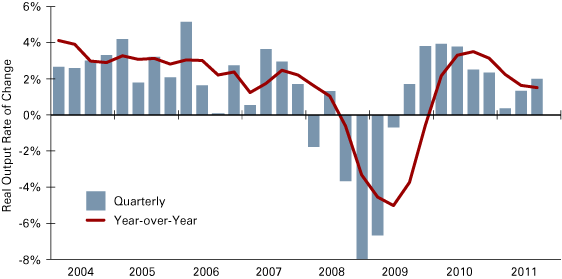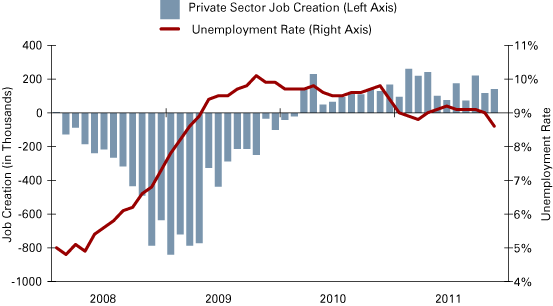U.S. Outlook for 2012
Professor Emeritus, Department of Economics, Indiana University Bloomington
The United States economy in 2011 managed to underachieve even relative to our unambitious expectation. A year ago, we thought growth would come in close to 3 percent for the year—certainly not great for an economy coming out of a very deep recession. Instead, the economy has expanded at an annual rate of only 1.2 percent through three quarters (see Figure 1).
Figure 1: U.S. Real Output Rate of Change, 2004 to 2011

Source: Bureau of Economic Analysis
The labor market has done even worse. We anticipated job growth would average very close to 200,000 per month in 2011. Through November the actual outcome has been just 132,000 jobs (see Figure 2). The difference means that unemployment has remained close to 9 percent, not the modest decline we had forecast.
Figure 2: U.S. Job Creation and Unemployment Rate, 2008 to 2011

Source: Bureau of Economic Analysis
The blame for this dismal outcome is widely shared, but two items, one man-made and the other an act of God, top the list. The latter was the earthquake and tsunami that hit Japan in March. The disruption to supply chains had a temporary, but clearly negative, effect during the summer.
The man-made component is the inability of the political sector—both domestically and abroad—to make some tough decisions. At home, this has manifested itself as a series of deadline-driven crises that have all ended with a non-decision to delay any substantive action. The cumulative effect has been to ratchet up uncertainty and destroy what remains of household and business confidence that policy will shift from being mostly counterproductive to being a positive force for sustained recovery.
The global component is centered on Europe and its sovereign debt situation. As in the United States, leaders have taken half steps that are mostly designed to avoid the fundamental problem and to delay the point of real decision.
Looking to the future, these political problems seem unlikely to turn in a productive direction in the near term. As a result, we expect that 2012 will be generally similar to 2011: unacceptably slow growth, without much progress in the labor market. To be more specific:
-
We expect output to grow between 2.5 and 3 percent on a fourth-quarter to fourth-quarter basis. This will be better than 2011, due to somewhat improved household spending and less drag from the government sector.
-
Employment will continue to increase, but only enough to allow marginal progress in reducing unemployment. By the end of 2012, unemployment will still be above 8 percent.
-
Higher commodity prices raised inflation significantly in 2011. This situation has moderated recently, and we expect inflation to be well contained in 2012.
-
The housing sector has hit bottom, but the large overhang of homes in or headed for foreclosure will prevent any significant rebound in construction or prices during most of 2012.
-
The Federal Reserve lowered short-term interest rates to virtually zero almost three years ago and has said it will maintain this stance through mid-2013. It is also engaging in realignment of its very large security portfolio toward longer-term holdings in an attempt to edge down long-term rates. This is unlikely to have any dramatic effect.
- Any actions on the federal deficit/debt will be mostly smoke and mirrors with little impact on the actual budget for the next year. Real change will be postponed until after the election.
Thus, we see continuing tepid economic recovery during 2012, with disappointing output expansion, low inflation and a small decline in unemployment. This is better than a slide back into recession, but is a long way from an optimistic outlook.
Moreover, like a year ago, there is a substantial roster of things that could adversely upset our expectations. In terms of immediacy, the European situation tops the list. On a daily basis, news of “progress” or of some impediment is causing triple-digit swings in financial markets. But, so far, there is little evidence of the will to confront (or even to recognize) the underlying problem—several countries in the EU periphery have been living beyond their means with the excess financed abroad. The result is debt burdens that have become unsustainable. Proposals to date have been focused on the debt problem. Solutions must, however, also deal with the imbalances between current standards of living and those that can be supported by domestic productivity. One way countries have traditionally dealt with this type of problem is by debasing their currency, which leads to a reduction in purchasing power and thereby a lowered standard of living. But the common European currency rules this out for, say, Greece. So the realignment requires more direct political actions, which so far don’t seem possible.
The U.S. is on a trajectory toward this same problem, but less far along, leaving more time to work out a solution. Our current dysfunctional political situation, however, is squandering that advantage. As in Europe, the problems we face require some fundamental changes. Instead of working on long-term solutions, however we have spent the last four years focused mostly on “fixes” that are short-term and temporary (and therefore ineffective). The result has been a lost half-decade. If the political deadlock is not broken by the next election, the danger of a lost decade will be very real.
Finally, the ongoing evolution of China must be mentioned. Regardless of how the European and U.S. problems are resolved, this evolution is likely to be the dominant economic story of the next decade. For the Chinese, the problems are enormous. They must transition from a low-wage economy driven by extraordinarily high levels of domestic investment and exports to a more consumer-oriented structure. Production must shift toward raising productivity, rather than simply expanding scale. The financial system must develop and become more open. These transitions will be extremely difficult to accomplish. Missteps could have significant ramifications for the entire global economy.
But all of this is further in the future. For the next year, our expectation is that neither Europe nor our domestic situation will self-destruct. This will be enough to produce in 2012 a year much like 2011—slow growth that doesn’t feel much like “recovery,” but better than possible alternatives.
Also in this Issue…
- Outlook for 2012
- International Outlook for 2012
- U.S. Outlook for 2012
- Financial Outlook for 2012
- Housing Market Outlook for 2012
- Indiana's Outlook for 2012
- Indiana's Agricultural Outlook for 2012
- Anderson Forecast 2012
- Bloomington Forecast 2012
- Columbus Forecast 2012
- Evansville Forecast 2012
- Fort Wayne Forecast 2012
- Gary Forecast 2012
- Indianapolis-Carmel Forecast 2012
- Kokomo Forecast 2012
- Lafayette Forecast 2012
- Louisville Forecast 2012
- Muncie Forecast 2012
- Richmond Forecast 2012
- South Bend and Elkhart Area Forecast 2012
- Terre Haute Forecast 2012




